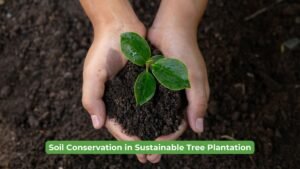Have you wondered how reforestation and afforestation can battle the environmental challenges faced by the Earth?
Both techniques aim to restore and enhance forest cover but differ in their methods and outcomes, which is the better path for India?
Let’s dive into the heart of this debate.
Understanding the Basics
Before we compare their impacts, let’s define the terms.
Reforestation involves planting trees on lands that have previously been forested but were cleared or degraded.
It aims to restore the ecological balance, leveraging the existing soil’s capacity to support a forest ecosystem once again.
Afforestation involves planting trees in areas where there were no forests before, turning empty and unused lands into new forests.
Reforestation and Afforestation: A Dual Strategy for India

India has many different types of land, like forests, mountains, and plains. But taking care of these places is hard because there are many different problems.
The question isn’t about choosing between reforestation and afforestation but understanding how each can play a vital role in securing a greener future.
The Role of Reforestation

Reforestation is crucial for restoring ecological balance.
It helps in rebuilding habitats for wildlife, conserving soil, and ensuring water security.
Reforestation in deforested areas revives green cover crucial for species survival, including humans.
Moreover, it’s an effective way to combat climate change as trees absorb carbon dioxide, a major greenhouse gas, from the atmosphere.
The Potential of Afforestation

Afforestation, on the other hand, opens new avenues for expanding forested areas, potentially transforming the landscape and creating new ecosystems.
It’s a forward-thinking approach that not only addresses environmental concerns but also contributes to the future of the Indian economy.
Afforestation can play a significant role in shaping the future of the Indian economy by fostering new industries related to forestry, eco-tourism, and green energy.
It also has the potential to improve air quality and create micro-climates that could benefit agriculture.
How Does Reforestation and Afforestation Limit the Effects of Climate Change?
Forests are a natural way of keeping the earth’s CO2 levels in check. The more trees there are, the more CO2 is captured and converted into oxygen through photosynthesis.
By absorbing CO2, forests help to lower the amount of greenhouse gasses in the atmosphere and reduce the effects of climate change.
Reforestation and afforestation help maximize these abilities of forests by increasing the overall amount of forested land on the planet.

Environmental Impacts of Afforestation
- Air Quality Improvement: Trees act as natural air filters, trapping pollutants and particulate matter from the air.
- Soil Protection: Afforestation can help in preventing soil erosion, maintaining soil fertility, and protecting watersheds.
- Water Management: Trees absorb water from the soil and release it through transpiration, regulating climate patterns. Afforestation reduces surface runoff, controlling flooding.
Environmental Impacts of Reforestation
- Carbon Sequestration: Reforestation helps in capturing and storing carbon dioxide from the atmosphere.
- Soil Protection: Reforestation helps in preventing soil erosion and degradation.
- Habitat Restoration: Reforestation restores natural habitats for wildlife and contributes to the recovery of endangered species.
5 Challenges and Considerations in Afforestation
1. Choice of Species
- Native vs. Non-native Species: Planting non-native species can disrupt local ecosystems, outcompete native flora, and lead to a reduction in biodiversity. It’s essential to choose species that are native to the area and can support local wildlife.
- Mono-cultures vs. Diversity: Creating mono-cultures (planting a single tree species) can make forests more susceptible to diseases and pests. A diversity of species ensures a more resilient ecosystem.
2. Impact on Local Ecosystems
- Water Usage: Trees need water to grow, leading to competition for water resources in areas where water is scarce, potentially affecting local agriculture and communities.
- Soil Quality: Afforestation can alter the soil composition and nutrient levels, which might not always be beneficial for the local environment.
3. Socio-economic Considerations
- Land Rights: The land chosen for afforestation could be subject to disputes or be critical for local communities for agriculture or as part of their cultural heritage.
- Economic Impact: Afforestation can boost employment and local economies but may also disrupt traditional livelihoods reliant on farming or grazing due to changes in land use.
4. Climate Considerations
- Carbon Sequestration Potential: Tree species choice significantly affects afforestation’s carbon sequestration efficiency and its impact on carbon dioxide reduction.
- Albedo Effect: Planting forests in areas that were previously covered by snow or ice can lead to a decrease in the albedo effect (the reflection of sunlight), potentially leading to localized warming.
5. Long-term Sustainability
- Maintenance and Protection: Young plantations need to be protected from wildfires, pests, and diseases.
- Adaptation to Climate Change: Tree species must be selected not only for current climate conditions but also for their ability to adapt to future climate changes.
5 Challenges and Considerations in Reforestation
1. Ecological Considerations
- Appropriate Species Selection: Choosing the right species that are native to the area is crucial. Non-native species can disrupt local ecosystems and biodiversity.
- Restoring Ecological Integrity: Reforestation should aim to restore the forest’s original structure, function, and diversity, rather than just increasing tree cover.
2. Site Conditions
- Degradation Level: Severely degraded lands may require initial soil restoration and protection measures before trees can be successfully planted.
- Climate Adaptation: Species selected for reforestation should be adaptable to current and future climate conditions, considering global climate change.
3. Biodiversity
- Enhancing Biodiversity: Reforestation should aim to enhance biodiversity, supporting a wide range of plant and animal species.
- Avoiding Mono-cultures: Planting a variety of species rather than monocultures helps prevent diseases and pests and supports a healthier ecosystem.
4. Socio-Economic Factors
- Community Engagement: Local communities should be involved in the reforestation process to ensure that projects meet their needs and respect their rights to land and resources.
- Economic Viability: Reforestation projects must be economically viable, providing benefits such as jobs, ecosystem services, and potentially sustainable timber and non-timber products.
5. Maintenance and Monitoring
- Protection from Threats: Reforested areas need protection from threats such as logging, fire, and agricultural expansion.
- Ongoing Monitoring: Regular monitoring is necessary to assess the success of reforestation efforts and to adapt management practices as needed.
What’s Best for India’s Future?
The answer lies in embracing both reforestation and afforestation as complementary strategies.
While reforestation aims to heal and restore, afforestation seeks to innovate and expand.
Together, they can create a resilient and diverse environmental framework that supports sustainable development and the well-being of future generations.
The future of the Indian economy is intrinsically linked to how effectively we manage our natural resources.
Implementing both reforestation and afforestation ensures a holistic approach to environmental conservation, fostering economic growth while preserving the planet.
The Future of the Indian Economy and Environmental Sustainability
Integrating both reforestation and afforestation into India’s environmental policy is key to sustainable development.
These initiatives promote sustainable agriculture, reduce fossil fuel dependency, and mitigate climate change impacts, bolstering India’s economy.
They offer a pathway to not only preserving the environment but also enhancing economic opportunities for rural and urban populations alike.
Engaging Communities and Government

The success of reforestation and afforestation initiatives heavily relies on the active participation of local communities and the support of government policies.
Creating awareness and educating people about the benefits of these practices can lead to more inclusive and effective conservation efforts.
Moreover, government policies that incentivize reforestation and afforestation can significantly accelerate the pace at which these initiatives are implemented.
FAQs
Q: How does afforestation benefit the environment?
A: Afforestation helps in creating new ecosystems, reduces desertification, improves air quality, and combats climate change by absorbing carbon dioxide.
Q: Can reforestation and afforestation help prevent floods?
A: Yes, both practices can help in water conservation and soil retention, reducing the risk of floods.
Q: How can I contribute to reforestation or afforestation?
A: You can contribute by supporting NGOs, participating in local tree-planting initiatives, or adopting sustainable practices in your daily life.
Q: What are the primary differences between reforestation and afforestation?
A: Reforestation involves planting trees in areas where forests have been cut down or degraded, while afforestation refers to creating forests in areas that previously had no tree cover.
Q: How do reforestation and afforestation impact climate change?
A: Both practices help combat climate change by sequestering carbon dioxide, a major greenhouse gas, thus reducing the overall concentration of CO2 in the atmosphere.
Q: Can afforestation and reforestation contribute to the economy?
A: Yes, they boost the economy by generating jobs in forestry, ecotourism, conservation, enhancing sustainable agriculture, and cutting climate change-related costs.
Conclusion
The debate of reforestation vs. afforestation is not about choosing one over the other but recognizing the unique benefits each brings to the table.
As we strive towards a sustainable future, we must employ both strategies in tandem to address the environmental challenges facing India.
By doing so, we not only contribute to the preservation of our planet but also pave the way for economic growth and prosperity.
Let’s join hands in making reforestation and afforestation a cornerstone of India’s environmental strategy.
Are you ready to make a difference? Join Nelda in our next tree-planting campaign and be a part of the change. Together, we can shape a brighter future for India and the world.
Written by Priyanka Velhal from Nelda. Images have the copyrights of their respective sources.




